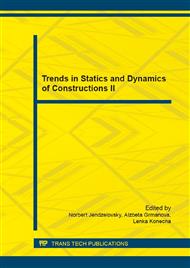[1]
J. Burland, Small is beautiful - the stiffness of soils at small strains, 9th Laurits Bjerrum memorial lecture, Canadian Geotechnical Journal 26 (1989) 499-516.
DOI: 10.1139/t89-064
Google Scholar
[2]
R.J. Jardine, D.M. Potts, H.D. St. John and D.W. Hight, Some practical applications of a non-linear ground model, in.: Proc. 10th ECSMFE, 1991, Firenze, Italy, pp.223-228.
Google Scholar
[3]
F.E. Richart, J.R. Hall and R.D. Woods, Vibrations of soils and foundations, Englewood Cliffs, Prentice-hall, New York, (1970).
Google Scholar
[4]
B.O. Hardin, V.P. Drnevich, Shear modulus and damping in soils: measurements and parameter effects, Journal of the Soil Mechanics and Foundation Division, ASCE 98 (1972) 603-624.
DOI: 10.1061/jsfeaq.0001756
Google Scholar
[5]
R.J. Jardine, Characterising soil behaviour at small to moderate strains, in: Int. Symp. Pre-failure Deformation Characteristics of Geomaterials-Measurement and Application, 1994, Is-Hokkaido, Sapporo.
Google Scholar
[6]
M. Jamiolkowski, R. Lancellotta, D.C.F. Lo Presti, Remarks on the stiffness at small strains of six Italian clays, in: 1st Int. Conf. Pre-failure Deform. Character. Geomater. 1994, Sapporo, pp.817-836.
Google Scholar
[7]
R.J. Jardine, Some observations on the kinematic nature of soil stiffness, Soils and Foundations 32 (1992) 111-124.
DOI: 10.3208/sandf1972.32.2_111
Google Scholar
[8]
G.R. McDowell, K.W. Hau, A simple non-assosiated three surface kinematic hardening model, Geotechnique 53 (2003) 433-437.
DOI: 10.1680/geot.53.4.433.37321
Google Scholar
[9]
T. Benz, Small-strain stiffness of soils and its numerical consequences. PhD Thesis, (2007).
Google Scholar
[10]
M. Gryczmanski, R. Uliniarz, A simple critical state model with small strain nonlinearity for overconsolidated soils, Foundations of Civil and Environmental Engineering 12 (2008) 49-60.
Google Scholar
[11]
B.O. Hardin, The nature of stress-strain behaviour for soils. State-of-the-art report, in: Proc. of specialty conference on earthquake engineering and soil dynamics, ASCE, New York, 1978, pp.3-90.
Google Scholar
[12]
J. Briaud, R.M. Gibbens, Predicted and measured behavior of five spread footings on sand, ASCE, New York, (1994).
Google Scholar
[13]
K.M. Chua, L. Xu, E. Pease, S. Tamare, Settlement of the test footings: Predictions from the University of Mexico, in: Briaud, J. & Gibbens, R.M. (Eds. ), Results of a Spread Footing Prediction Symposium, ASCE, New York, (1994).
Google Scholar


